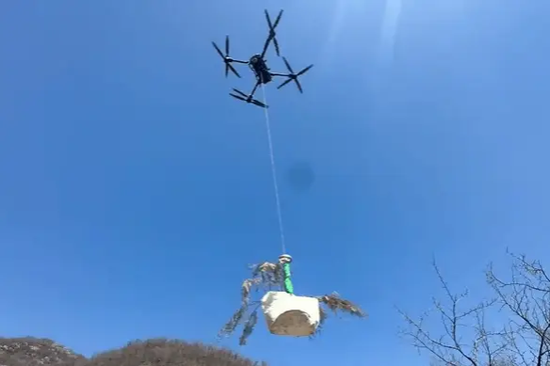Drones plant seedlings on Beijing's cliffs
A fleet of drones took to the skies above the Yanshan Mountains in northern Beijing on Monday, delivering tree seedlings to steep slopes 800 meters above sea level as part of the capital's first drone-assisted forest planting project.
The initiative, located in the Shixia area of Badaling Forest Farm under the Three-North Shelterbelt Forest Program, aims to improve the efficiency of traditional forest planting while reducing environmental disruption.
"Each drone can carry more than 10 seedlings per trip, allowing precise planting in difficult cliff areas and reducing harm to existing plants," said Yao Yonggang, a grassland and forestry expert who was appointed Party chief of Yumugou Village last year. According to the forest farm's management, drone technology has made cliffside planting feasible — a key step in expanding green spaces near urban areas.
This spring, Badaling Forest Farm, a major component of China's Three-North Shelterbelt Forest Program, adopted cutting-edge technologies to support ecological restoration. As part of the program's sixth phase, the farm aims to restore 543 hectares of artificial forests and degraded woodlands by 2025.
In addition to the drone initiative, the farm plans to build a "colorful "Great Wall landscape that incorporates cultural heritage into forest conservation efforts.
"In the past, it was a dusty land near the place, and now it has become a green shield for the Great Wall," said Fang Hao, a nearby resident.
According to local authorities, Badaling Forest Farm has transformed from a barren area with less than 4 percent forest cover to a lush belt with 75 percent coverage.
Yao has also promoted a rural revitalization model that combines ecological and economic goals. Over the past two years, villagers have planted 1,000 Chinese toona trees and 300 cherry trees on previously barren slopes, creating a "green bank" expected to generate profit by 2026.
China's Three-North Shelterbelt Forest Program is a 70-year initiative launched in 1978 to combat desertification in northern regions. Recent innovations such as drone seeding and AI-powered planting robots have become vital tools in areas such as the Inner Mongolia autonomous region, where desert control remains a high priority.
dujuan@chinadaily.com.cn

